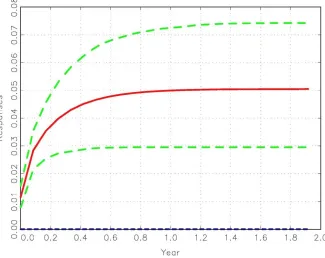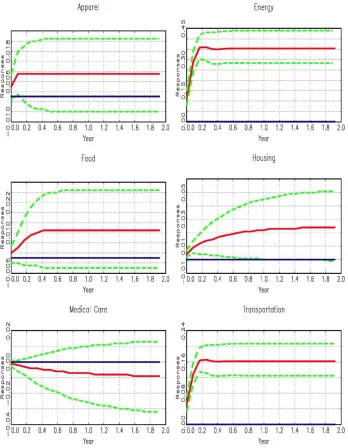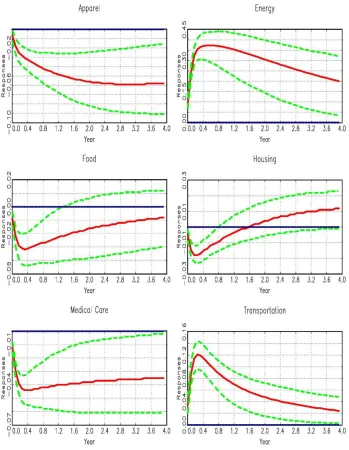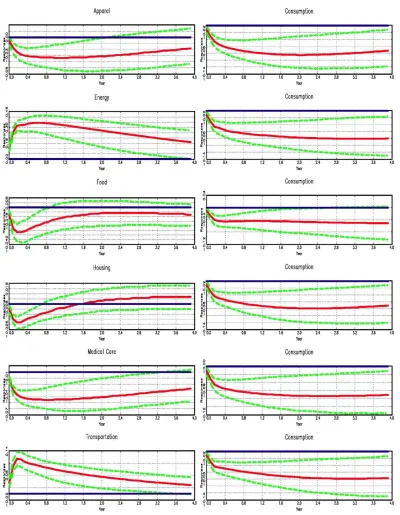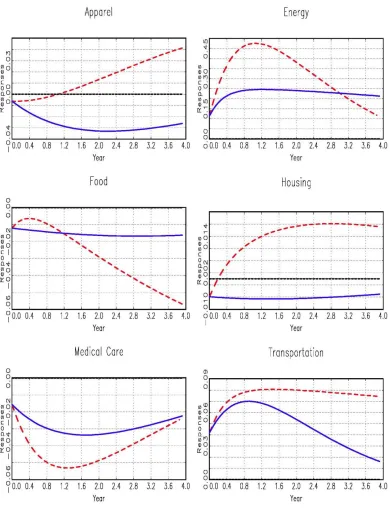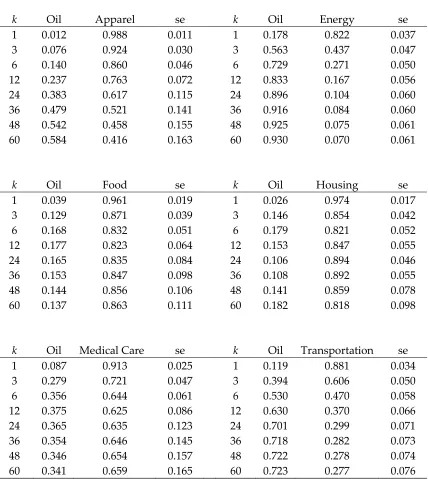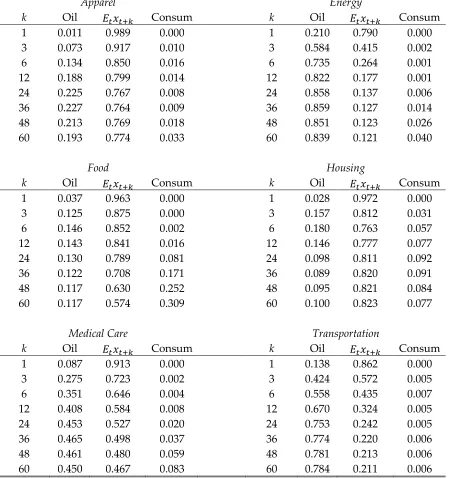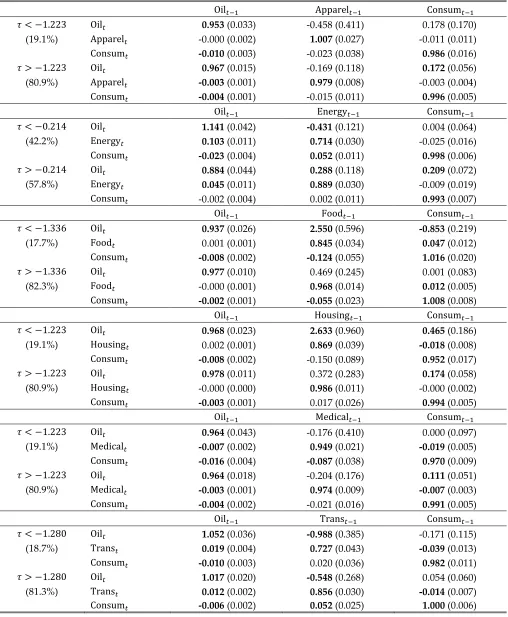Munich Personal RePEc Archive
How Does the Oil Price Shock Affect
Consumers?
Gao, Liping and Kim, Hyeongwoo and Saba, Richard
6 September 2013
Online at
https://mpra.ub.uni-muenchen.de/49565/
How Does the Oil Price Shock Affect Consumers?
Liping Gao
, Hyeongwoo Kim
†, and Richard Saba
‡September 2013
Abstract
This paper evaluates the degree of the pass-through effect of the oil price shock to six CPI sub-indices in the US. We report substantially weaker pass-through effects in less energy-intensive sectors compared with those in more energy-intensive sectors. We attempt to find an explanation for this from the role of spending adjustments when there’s an unexpected change in the oil price. Using linear and nonlinear framework, we find substantial decreases in the relative price in less energy-intensive sectors, but not in energy-intensive sectors, which may be due to a substantial decrease in the demand for goods and services in those CPI sub-baskets. Our findings are consistent with those of Edelstein and Kilian (2009) in the sense that spending adjustments play an important role in price dynamics in response to unexpected changes in the oil price.
Key Words: Oil Price Shocks; Pass-Through Effect; Consumer Price Sub-Index; Income Effect; Threshold Vector Autoregressive Model
JEL Classification: E21; E31; Q43
School of Forestry & Wildlife Sciences, Auburn University, AL 36849, USA. Email: lzg0005@ auburn.edu. Tel: 1-334-844-8026.
†
Corresponding Author: Hyeongwoo Kim, Department of Economics, Auburn University, AL 36849, USA. Email: gmmkim@gmail.com. Tel: 1-334-844-2928. Fax: 1-334-844-4615.
‡
1 Introduction
As Barsky and Kilian (2002) argue oil price shocks are unambiguously inflationary, especially when one uses the consumer price index (CPI) inflation rate to measure the pass-through effect of the shock. On the other hand, Edelstein and Kilian (2009) point out that the oil price shock may have substantial income effects on the demand for goods and services, which may be related with earlier findings by Darby (1982) and Gisser and Goodwin (1986) who reported strong real effects of oil prices in addition to inflationary effects.
Hamilton (1996) observes that oil prices behaved somewhat differently since the mid-1980s, and that changes in the oil price are found to affect the macro economy primarily by depressing demand for key consumption and investment goods. Many researches have investigated the macroeconomic effect of the oil price shock, see among others, Ferderer (1996), Bernanke et al. (1997), Colognia and Manera (2008), Kilian (2009), Korhonen and Ledyaeva (2010), Kilian and Lewis (2011), and Zhang (2012).
This paper proposes the possibility that recessionary and inflationary effects of an oil price shock may result in heterogeneous responses of sector CPI sub-indices. For this purpose we employ linear and nonlinear structural vector autoregressive (VAR) models to estimate the pass-through effect of the oil price shock on six CPI sub-indices in the US. We find strong evidence of spending adjustment effects that limit the pass-through effect of the shock on the apparel, food, housing, and medical care price indices (less energy-intensive sectors), but not on the energy and transportation price indices. That is, consumer welfare loss is primarily driven by a strong pass-through effect in energy-intensive sectors.
2 Data Descriptions and Pass-Through Effects of the Oil Price Shock
We obtained all data from Federal Reserve Economic Data (FRED). The oil price is the spot western Texas intermediate (WTI). Six CPI sub-indices include: Apparel (CPIAPPSL), Energy (CPIENGSL), Food (CPIUFDSL), Housing (CPIHOSSL), Medical Care (CPIMEDSL), and Transportations (CPITRNSL) as well as the total CPI (CPIAUCSL).1 Observations are monthly
and span from 1974 M1 to 2011 M3.2 We also use Personal Consumption Expenditures (PCE)
to investigate expenditure adjustment effects in augmented models.
To establish a benchmark we report the impulse response function of the US CPI to an oil price shock in Figure 1. For this purpose, we use the following conventional bivariate vector autoregressive (VAR) model for the spot oil price ( ) and the total CPI ( ), expressed in natural logarithms.
( ) (1)
where , ( ) denotes the lag polynomial matrix, is a vector of normalized underlying shocks, and is a matrix that describes the contemporaneous relationships among
and .3 We obtain the conventional orthogonalized impulse-response function (OIRF)
by Sims (1980).4
As in Barsky and Kilian (2002), we observe a strong and significant pass-through effect on aggregate CPI. We observe strictly positive point estimates of CPI responses to an oil shock
1 We omit the Food and Beverage index because we obtained similar results as that from the Food index. Other
categories such as Education and Recreations are omitted due to lack of observations.
2 Observations prior to 1974 are not used due to the collapse of the Bretton Woods system in 1973 that creates a
structural break in oil price dynamics. We are not interested in this particular issue.
3 To get the response of the level variable, we report the accumulated impulse-response function from a bivariate
vector autoregressive model with differenced variables. The oil price inflation is ordered first with an assumption that the US CPI inflation does not contemporaneously affect the oil price inflation within one month.
4 Kim (2012) shows that the OIRF is the same as the generalized impulse-response function (GIRF) by Pesaran and
along with a compact 95% confidence band that was obtained from 2,000 nonparametric bootstrap replications.
It should be noted, however, that the degree of the pass-through effect of the oil price shock is quite different across CPI sub-indices ( ) when we do the same analysis by replacing with (Figure 2).
As seen in Figure 2, we obtain mixed responses to the positive oil price shock. We observed insignificant responses for the apparel, food, and medical care indices, while strong and significantly positive responses are estimated for the energy and transportation indices. The significantly positive pass-through effect to the housing price, however, was short term and lasts only for about one year. In a nutshell, we found that the pass-through effect of the oil price shock to overall CPI might have been driven by substantial responses of prices in energy-intensive sectors. In what follows, we investigate the role of economic factors, focusing on the role of adjustments of consumption due to income changes, which may explain such heterogeneous responses of CPI sub-indices to the oil price shock.
Figures 1 and 2 around here
3 Responses of the Relative Price
In this section, we study the response of a CPI sub-index relative to the total CPI to the oil price shock, which is also deflated by the total CPI. Note that a decrease (increase) in the relative CPI sub-index to a positive real oil price shock implies a relatively weaker (stronger) response of the CPI sub-index to the response of the total CPI, which might occur when the composition of consumption goods changes when the oil price increases unexpectedly.
we construct the following bivariate VAR( ) model for relative prices with deterministic trends.5
( ) (2)
where
[ ] [ ],
is a diagonal coefficient matrix for the deterministic terms in , ( ) denotes the lag polynomial matrix, is a vector of normalized underlying structural shocks ( ), and is a lower triangular matrix that describes the contemporaneous relationships among and . Again, we obtain the conventional orthogonalized impulse-response function (OIRF) by Sims (1980) and the variance decomposition analysis is implemented from this framework. 95% confidence bands are constructed by taking 2.5% and 97.5% percentiles from 2,000 nonparametric bootstrap simulations.
Responses to the oil price shock are reported in Figure 3. Note that the relative price (price share) exhibits significantly negative movements at least in the short-run for the apparel, food, housing, and medical care sub-indices. We observed very persistent upward movements of relative prices in energy-intensive sectors, that is, the energy and transportation sub-indices.
Our findings are consistent with that of Edelstein and Kilian (2009) in the sense that the spending adjustment effect plays an important role in determining the price dynamics. Unexpected changes in the oil price shift not only the supply but also the demand curve of goods and services to the left due to a decrease in purchasing power of discretionary income. When the demand for energy is inelastic, unexpected increases in the oil price result in disposable income for other goods and services. If the oil price shock results in a persistent negative effect on income growth, consumer spending will be further depressed over time.
When the demand responds substantially, relative price in that sector is likely to fall, which is consistent with a limited or weak pass-through effect on prices in less energy-intensive sectors.
Insert Figure 3 around here
We also implement the variance decomposition analysis to see how much variations of each sub-index are explained by the oil price shock (see Table 1). We observe a dominant role of the oil shock only for the energy and transportation sub-indices, while limited roles of the shock were observed for the apparel, food, housing, and medical care sub-indices especially in the short-run. For example, the oil price perturbation explains only 1.2% of variations in the one-period ahead forecast of the apparel sub-index, whereas it explains 17.8% for the energy sub-index. Furthermore, the former is insignificant at the 5% level, while the latter is significant at any conventional levels. In the longer-run, the oil price shock explains 13.7% of 5-year ahead forecast of the food sub-index, while 72.3% for the transportation sub-index.
Insert Table 1 around here
Next, we augment the current system to a trivariate VAR model by adding the personal consumption expenditures (PCE) deflated by the CPI ( ), replacing in equation (2) by
, to see if the oil price shock results in a non-negligible adjustment effect in consumer spending.
We note that all response function estimates of relative prices in Figure 4 are qualitatively similar to those from the bivariate model. More importantly, we observe significantly negative responses of the real consumption expenditures in response to the oil price shock for all cases.6 These findings provide further evidence of substantial role of the
6 We further experimented with an augmented VAR with the industrial production. Results confirm prolonged
negative income effect.The variance decomposition analysis from this trivariate VAR models is reported in Table 2, which is also consistent with that of the bivariate model.
Insert Figure 4 and Table 2 around here
4 Regime-Specific Responses of the Relative Price
We further investigate possibilities of regime-specific responses of CPI sub-indices to the oil price shock. For this purpose, we employ the following simple threshold trivariate VAR model.
( ) ( ) ( ) ( ) (3)
where , ( ) is an indicator function, is a -period lagged threshold variable, is the chosen threshold value, and ( ) and ( ) denote lag polynomials in the upper and the lower regime, respectively.
We use the growth rate of the real industrial production (IP) for the threshold variable and set which is a conventional value. We employed a grid search method by choosing
that minimizes the determinant of the variance-covariance matrix. We trimmed off the
upper and lower 10% of the distribution of IP prior to estimation. Coefficient estimates in the lower and upper regimes are reported in Table 3, and we also demonstrate regime-specific response function estimates in Figure 5.7
Note two things about the estimated threshold values. First, estimates are roughly similar to each other with an exception of the system with the energy sub-index. Second, the majority of observations belong to the upper regime for most cases except the VAR with the energy sub-index.
7 We report these regime-specific responses instead of the generalized impulse-response function analysis
The one-period lagged oil price affects 4 and 3 sub-indices significantly at the 5% level in the upper and lower regime, respectively. The effect of the lagged oil price is quantitatively larger in the lower regime for the energy and the transportation sub-indexes, which seems reasonable because the income effect may play a more important role when the economy is relatively worse. Likewise, the lagged oil price has a bigger coefficient in absolute value for the medical sub-index, which implies that the medical sub-index rises more slowly than the total CPI when the economy enters a period of downturns. For other sub-indices, we obtained insignificant contemporaneous effects. We investigate dynamic effects over time via the impulse-response function estimates in Figure 5.
Regime-specific conditional impulse-response functions during upper regimes (solid lines) are overall consistent with those from the linear bivariate and trivariate models. This result is not surprising since about 80% of observations belong to the upper regime.
Several interesting results from response function estimates are as follows. There are greater responses during the lower growth regime (dashed) compared with those during the upper growth regime for the energy sub-index. Since observations are split about 42% and 57% in the lower and higher regime for this index, one cannot ignore the different response estimates. These greater responses during the low growth regime seem consistent with Edelstein and Kilian (2009), because the negative income effect would become greater when the economy is bad, resulting in weaker responses of less energy-intensive product prices compared with those of more energy-intensive goods prices. The transportation sub-index also exhibit similar estimates.
Insert Table 3 and Figure 5 around here
5 Concluding Remarks
This paper empirically evaluates the role of spending adjustments when there is an oil price shock using six CPI sub-indices in the US. We find limited pass-through effects of the oil price shock on the apparel, food, housing, and medical care CPI sub-indices compared with those on more energy-intensive industry indices such as the energy and transportation prices.
References
Barsky, R., & Kilian, L. (2002), “Do we really know that oil caused the great stagflation? A
monetary alternative,” in NBER Macroeconomics Annual 2001, Benjamin Bernanke and
Kenneth Rogoff (Eds.), 137-183.
Barsky, R., & Kilian, L. 2004. Oil and the macroeconomy since the 1970s. Journal of Economic Perspectives, American Economic Association, 18(4), 115-134.
Bernanke, B.S., Gertler, M., & Watson, M. 1997. Systematic monetary policy and the effects of oil price shocks. Brookings Papers on Economic Activity, 91–157.
Colognia, A., & Manera, M. 2008. Oil prices, inflation and interest rates in a structural cointegrated VAR model for the G-7 countries. Energy Economics, 30(3), 856–888.
Darby, M.R. 1982. The price of oil and world inflation and recession. The American Economic Review, 72(4), 738-751.
Edelstein, P., & Lutz, K. (2009), “How sensitive are consumer expenditures to retail energy
prices?” Journal of Monetary Economics 56, 766-779.
Ferderer, J.P. 1996. Oil price volatility and the macroeconomy. Journal of Macroeconomics, 18(1), 1–26.
Gisser, M., & Goodwin, T.H. 1986. Crude oil and the macroeconomy: Tests of Some Popular Notions. Journal of Money, Credit and Banking, 18(1), 95-103.
Hamilton, J.D. 1996. This is what happened to the oil price-macroeconomy relationship. Journal of Monetary Economics, 38, 215 –220.
Kilian, L. 2009. Exogenous oil supply shocks: how big are they and how much do they matter for the U.S. economy? The Review of Economics and Statistics, 90(2), 216 – 240.
Kilian, L. & Lewis, L.T. 2011. Does the fed respond to oil price shocks? The Economic Journal, 121, 1047–1072.
Koop, Gary & Pesaran, M. Hashem & Potter, Simon M., 1996. Impulse response analysis in nonlinear multivariate models. Journal of Econometrics, 74(1), 119-147.
Korhonen, I. & Ledyaeva, S. 2010. Trade linkages and macroeconomic effects of the price of oil. Energy Economics, 32, 848–856.
Pesaran, M. H., & Shin Y. (1998), “Generalized impulse response analysis in linear multivariate
models,” Economics Letters 58, 17-29.
Sims, C. A. (1980), “Macroeconomics and reality,” Econometrica 48, 1-48.
Figure 1. Consumer Price Index Response to an Oil Price Shock
Figure 2. Sectoral Responses to an Oil Price Shock
Figure 3. Price Share Responses to an Oil Price Shock
Figure 4. Price Share Responses to an Oil Price Shock: Trivariate Models
Figure 5. Regime Specific Impulse-Response Function Estimations
Table 1. Variance Decomposition Analysis for
k Oil Apparel se k Oil Energy se 1 0.012 0.988 0.011 1 0.178 0.822 0.037 3 0.076 0.924 0.030 3 0.563 0.437 0.047 6 0.140 0.860 0.046 6 0.729 0.271 0.050 12 0.237 0.763 0.072 12 0.833 0.167 0.056 24 0.383 0.617 0.115 24 0.896 0.104 0.060 36 0.479 0.521 0.141 36 0.916 0.084 0.060 48 0.542 0.458 0.155 48 0.925 0.075 0.061 60 0.584 0.416 0.163 60 0.930 0.070 0.061
k Oil Food se k Oil Housing se 1 0.039 0.961 0.019 1 0.026 0.974 0.017 3 0.129 0.871 0.039 3 0.146 0.854 0.042 6 0.168 0.832 0.051 6 0.179 0.821 0.052 12 0.177 0.823 0.064 12 0.153 0.847 0.055 24 0.165 0.835 0.084 24 0.106 0.894 0.046 36 0.153 0.847 0.098 36 0.108 0.892 0.055 48 0.144 0.856 0.106 48 0.141 0.859 0.078 60 0.137 0.863 0.111 60 0.182 0.818 0.098
k Oil Medical Care se k Oil Transportation se 1 0.087 0.913 0.025 1 0.119 0.881 0.034 3 0.279 0.721 0.047 3 0.394 0.606 0.050 6 0.356 0.644 0.061 6 0.530 0.470 0.058 12 0.375 0.625 0.086 12 0.630 0.370 0.066 24 0.365 0.635 0.123 24 0.701 0.299 0.071 36 0.354 0.646 0.145 36 0.718 0.282 0.073 48 0.346 0.654 0.157 48 0.722 0.278 0.074 60 0.341 0.659 0.165 60 0.723 0.277 0.076
Note: Variance decomposition analysis is implemented from a bivariate vector autoregressive model with the real oil price ordered first. is the k-period (month) ahead forecast of the variable x (each sub-index) at time t and
Table 2. Variance Decomposition Analysis: Tri-Variate Models
Apparel Energy
k Oil Consum k Oil Consum 1 0.011 0.989 0.000 1 0.210 0.790 0.000 3 0.073 0.917 0.010 3 0.584 0.415 0.002 6 0.134 0.850 0.016 6 0.735 0.264 0.001 12 0.188 0.799 0.014 12 0.822 0.177 0.001 24 0.225 0.767 0.008 24 0.858 0.137 0.006 36 0.227 0.764 0.009 36 0.859 0.127 0.014 48 0.213 0.769 0.018 48 0.851 0.123 0.026 60 0.193 0.774 0.033 60 0.839 0.121 0.040
Food Housing
k Oil Consum k Oil Consum 1 0.037 0.963 0.000 1 0.028 0.972 0.000 3 0.125 0.875 0.000 3 0.157 0.812 0.031 6 0.146 0.852 0.002 6 0.180 0.763 0.057 12 0.143 0.841 0.016 12 0.146 0.777 0.077 24 0.130 0.789 0.081 24 0.098 0.811 0.092 36 0.122 0.708 0.171 36 0.089 0.820 0.091 48 0.117 0.630 0.252 48 0.095 0.821 0.084 60 0.117 0.574 0.309 60 0.100 0.823 0.077
Medical Care Transportation
k Oil Consum k Oil Consum 1 0.087 0.913 0.000 1 0.138 0.862 0.000 3 0.275 0.723 0.002 3 0.424 0.572 0.005 6 0.351 0.646 0.004 6 0.558 0.435 0.007 12 0.408 0.584 0.008 12 0.670 0.324 0.005 24 0.453 0.527 0.020 24 0.753 0.242 0.005 36 0.465 0.498 0.037 36 0.774 0.220 0.006 48 0.461 0.480 0.059 48 0.781 0.213 0.006 60 0.450 0.467 0.083 60 0.784 0.211 0.006
Note: Variance decomposition analysis is implemented from a trivariate vector autoregressive model with the real oil price ordered first, while the real consumption expenditure, denoted Consum, is ordered last. is the
Table 3. Threshhold Vector Autoregressive Model Estimations
0.953 (0.033) -0.458 (0.411) 0.178 (0.170)
(19.1%) -0.000 (0.002) 1.007 (0.027) -0.011 (0.011)
-0.010 (0.003) -0.023 (0.038) 0.986 (0.016)
0.967 (0.015) -0.169 (0.118) 0.172 (0.056)
(80.9%) -0.003 (0.001) 0.979 (0.008) -0.003 (0.004)
-0.004 (0.001) -0.015 (0.011) 0.996 (0.005)
1.141 (0.042) -0.431 (0.121) 0.004 (0.064)
(42.2%) 0.103 (0.011) 0.714 (0.030) -0.025 (0.016)
-0.023 (0.004) 0.052 (0.011) 0.998 (0.006)
0.884 (0.044) 0.288 (0.118) 0.209 (0.072)
(57.8%) 0.045 (0.011) 0.889 (0.030) -0.009 (0.019)
-0.002 (0.004) 0.002 (0.011) 0.993 (0.007)
0.937 (0.026) 2.550 (0.596) -0.853 (0.219)
(17.7%) 0.001 (0.001) 0.845 (0.034) 0.047 (0.012)
-0.008 (0.002) -0.124 (0.055) 1.016 (0.020)
0.977 (0.010) 0.469 (0.245) 0.001 (0.083)
(82.3%) -0.000 (0.001) 0.968 (0.014) 0.012 (0.005)
-0.002 (0.001) -0.055 (0.023) 1.008 (0.008)
0.968 (0.023) 2.633 (0.960) 0.465 (0.186)
(19.1%) 0.002 (0.001) 0.869 (0.039) -0.018 (0.008)
-0.008 (0.002) -0.150 (0.089) 0.952 (0.017)
0.978 (0.011) 0.372 (0.283) 0.174 (0.058)
(80.9%) -0.000 (0.000) 0.986 (0.011) -0.000 (0.002)
-0.003 (0.001) 0.017 (0.026) 0.994 (0.005)
0.964 (0.043) -0.176 (0.410) 0.000 (0.097)
(19.1%) -0.007 (0.002) 0.949 (0.021) -0.019 (0.005)
-0.016 (0.004) -0.087 (0.038) 0.970 (0.009)
0.964 (0.018) -0.204 (0.176) 0.111 (0.051)
(80.9%) -0.003 (0.001) 0.974 (0.009) -0.007 (0.003)
-0.004 (0.002) -0.021 (0.016) 0.991 (0.005)
1.052 (0.036) -0.988 (0.385) -0.171 (0.115)
(18.7%) 0.019 (0.004) 0.727 (0.043) -0.039 (0.013)
-0.010 (0.003) 0.020 (0.036) 0.982 (0.011)
1.017 (0.020) -0.548 (0.268) 0.054 (0.060)
(81.3%) 0.012 (0.002) 0.856 (0.030) -0.014 (0.007)
